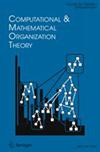扩展悖论的动态均衡模型:揭示组织中的耗散动态
IF 1.5
4区 管理学
Q3 COMPUTER SCIENCE, INTERDISCIPLINARY APPLICATIONS
Computational and Mathematical Organization Theory
Pub Date : 2022-04-01
DOI:10.1177/26317877221090317
引用次数: 1
摘要
组织的动态均衡模型已经成为悖论研究中一个很有影响的理论框架。该模型将悖论管理描述为走钢丝,因为参与者通过持续的微变化来应对矛盾的紧张关系。潜在的假设是,一旦参与者接受悖论,并以一贯不一致的方式支持对立的两极,他们就能有效地管理组织的紧张关系。我们认为,由于组织中悖论的突发性和不可预测性,矛盾张力不能以这种方式被纳入管理控制之下。因此,除了需要在钢索上保持平衡外,走钢丝的人可能会发现绳子突然被一阵强风拉向一个意想不到的方向。为了促进理论发展,我们提出了耗散平衡的概念,以更好地捕捉平衡的临时性质,以及管理层在出现超出管理层控制的意外发展时需要的持续警惕和干预,以(重新)平衡组织。本文章由计算机程序翻译,如有差异,请以英文原文为准。
Extending the Dynamic Equilibrium Model of Paradox: Unveiling the dissipative dynamics in organizations
The dynamic equilibrium model of organizing has become an influential theoretical framework in paradox research. The model describes paradox management as tightrope-walking, as actors cope with paradoxical tensions through continuous microshifts. The underlying assumption is that once actors accept the paradox and support opposing poles in a consistently inconsistent manner, they can effectively manage organizational tensions. We argue that paradoxical tensions cannot be subsumed under managerial control in this way due to the emergent and unpredictable nature of paradoxes in organizations. Hence, in addition to needing to balance on a tightrope, the tightrope walker may find the rope suddenly pulled in an unexpected direction by a strong gust of wind. To advance theory development, we put forward the concept of dissipative equilibrium to better capture the temporary nature of balance and the continuous vigilance and interventions needed from management to (re)balance an organization in the presence of unexpected developments that are beyond management’s control.
求助全文
通过发布文献求助,成功后即可免费获取论文全文。
去求助
来源期刊

Computational and Mathematical Organization Theory
COMPUTER SCIENCE, INTERDISCIPLINARY APPLICATIONS-MATHEMATICS, INTERDISCIPLINARY APPLICATIONS
CiteScore
3.80
自引率
16.70%
发文量
14
审稿时长
>12 weeks
期刊介绍:
Computational and Mathematical Organization Theory provides an international forum for interdisciplinary research that combines computation, organizations and society. The goal is to advance the state of science in formal reasoning, analysis, and system building drawing on and encouraging advances in areas at the confluence of social networks, artificial intelligence, complexity, machine learning, sociology, business, political science, economics, and operations research. The papers in this journal will lead to the development of newtheories that explain and predict the behaviour of complex adaptive systems, new computational models and technologies that are responsible to society, business, policy, and law, new methods for integrating data, computational models, analysis and visualization techniques.
Various types of papers and underlying research are welcome. Papers presenting, validating, or applying models and/or computational techniques, new algorithms, dynamic metrics for networks and complex systems and papers comparing, contrasting and docking computational models are strongly encouraged. Both applied and theoretical work is strongly encouraged. The editors encourage theoretical research on fundamental principles of social behaviour such as coordination, cooperation, evolution, and destabilization. The editors encourage applied research representing actual organizational or policy problems that can be addressed using computational tools. Work related to fundamental concepts, corporate, military or intelligence issues are welcome.
 求助内容:
求助内容: 应助结果提醒方式:
应助结果提醒方式:


